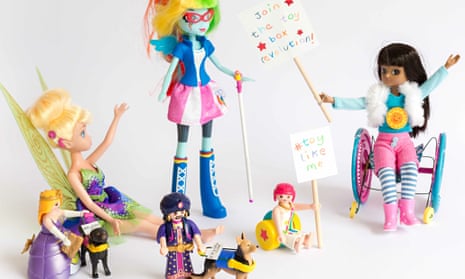Since my last child was born five years ago something else has bred in my house. Toys. We started off with a few rattles, and as the years progressed the plastic proliferated into an army of Playmobil figures, a soup of Lego, a sea of cutesy Sylvanian rabbits. But four weeks ago I stood back and looked at our toy box in a new light. A penny dropped. Not one plastic figure had a wheelchair, or a hearing aid, a white cane or any kind of disability at all.
There are 770,000 children in the UK with disabilities and more than 150 million worldwide. Yet these children arrive into a world where, even before they have left their mother’s lap, they are excluded by the very industry that exists to create their entertainment, the objects that fuel their development, the starting blocks of life: toys.
The global toy industry is worth £2.9bn but there are no wheelchair-using Barbies (Mattel’s toe-curlingly named Share a Smile Becky was discontinued several years ago along with American Sign Language Barbie). Playmobil’s answer to disability is a boy with a broken leg and an elderly man being pushed in a wheelchair by a young blonde woman. What does this say to children? That only old people need wheels? That childhood disability amounts to a few weeks with your leg in plaster and then goes away?
When I thought about the level of exclusion that was being carried out by these powerful global brands, the pied pipers of childhood, my rage rolled. I wanted to do something. You see, I was one of those kids. I’d grown up wearing hearing aids and never seen myself represented anywhere. There were no deaf people on TV, in the comics I read or the toys I played with.
So I messaged two friends with children with disabilities: Karen Newell, a former play consultant for Ragdoll Productions who has a son with visual impairment, and the deaf writer Melissa Mostyn who has a daughter with cerebral palsy. We set up a Facebook page and a Twitter account and started using the hashtag #toylikeme.
We asked people to send pictures of toys that reflected disability positively. Someone sent an American Girl doll with a hearing aid, then a bald Moxie doll. Then silence. So we started to make over our own toys, giving them impairments and posting the results online. Like a match to a firework factory, the whole thing went bang. Within days we went viral as parents shared our image of Disney’s Tinker Bell with a cochlear implant, made from a spray-painted popper stud and Fimo.
These parents, from all corners of the world, will have been on a very personal journey. They’ve experienced the shock and grief of finding out that their child is deaf or disabled, the angst of deciding whether to go ahead with a cochlear implant or other invasive procedures, the worry that their child will be excluded from society. An image that marries this emotional journey with the cultural recognisability of Disney provided the perfect cocktail of recognition and inclusion. Suddenly parents were sharing and liking Toy Like Me at a rate of one a minute.
Some small UK toy producers have been quick to answer the campaign call. Arklu, the makers of Lottie dolls, already produce 25% of their dolls with glasses and have agreed to look at ways to make future ranges more disability representative. Makies, the world’s only producers of 3D printed toys, have started producing a series of disability accessories for their existing range of bespoke dolls in the two weeks since we approached them.
But what of the big girls and boys of the toy world? The Legos, Mattels, Playmobils? We’ve tweeted them, we’ve tagged them, we’ve talked about them, we’ve sent them invites. But as yet, they still haven’t come out to play.
